Expression pattern of placenta specific 8 and keratin 20 in different types of gastrointestinal cancer
- PMID: 31974611
- PMCID: PMC6947936
- DOI: 10.3892/mmr.2019.10871
Expression pattern of placenta specific 8 and keratin 20 in different types of gastrointestinal cancer
Abstract
The aim of the present study was to investigate the expression of keratin 20 (KRT20) and placenta specific 8 (PLAC8) in gastrointestinal (GI) cancer with various differentiation phenotypes. The present study retrospectively investigated archived formalin‑fixed paraffin‑embedded tissue samples from 12 patients at different stages of GI cancer [four with gastric cancer, four with pancreatic cancer and four with colorectal cancer (CRC)]. The stages were pre‑determined, according to differentiation phenotypes, by a pathologist of the Department of Pathology at Sijhih Cathay General Hospital. KRT20 and PLAC8 expression levels were assessed using immunohistochemistry. The CRC cell lines SW620 and Caco‑2 were used to assess interactions between KRT20 and PLAC8 via reverse transcription‑quantitative PCR. PLAC8 and KRT20 expression was observed consistently only in the well‑differentiated CRC tissue samples. Low KRT20 expression levels were observed in the PLAC8 knockdown SW620 cells. In addition, there was a positive association between PLAC8 and KRT20 expression in the differentiated Caco‑2 cells. According to the results of the present study, the differentiation status of GI cancer influenced KRT20 expression, particularly in CRC, which may explain why patients with well‑differentiated CRC display better clinical outcomes. Therefore, the prognostic significance of KRT20 and PLAC8 may be particularly crucial for patients with CRC displaying a well‑differentiated phenotype.
Keywords: gastrointestinal cancer; keratin 20; placenta specific 8; poorly differentiated; well differentiated.
Figures
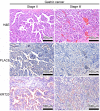

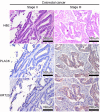
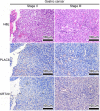
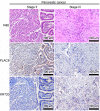
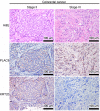

Similar articles
-
Multifaced roles of PLAC8 in cancer.Biomark Res. 2021 Oct 9;9(1):73. doi: 10.1186/s40364-021-00329-1. Biomark Res. 2021. PMID: 34627411 Free PMC article. Review.
-
Gastrointestinal differentiation marker Cytokeratin 20 is regulated by homeobox gene CDX1.Proc Natl Acad Sci U S A. 2009 Feb 10;106(6):1936-41. doi: 10.1073/pnas.0812904106. Epub 2009 Feb 2. Proc Natl Acad Sci U S A. 2009. PMID: 19188603 Free PMC article.
-
Overexpression of placenta specific 8 is associated with malignant progression and poor prognosis of clear cell renal cell carcinoma.Int Urol Nephrol. 2017 Jul;49(7):1165-1176. doi: 10.1007/s11255-017-1578-y. Epub 2017 Mar 27. Int Urol Nephrol. 2017. PMID: 28349447
-
Prognostic Role of Survivin and Macrophage Infiltration Quantified on Protein and mRNA Level in Molecular Subtypes Determined by RT-qPCR of KRT5, KRT20, and ERBB2 in Muscle-Invasive Bladder Cancer Treated by Adjuvant Chemotherapy.Int J Mol Sci. 2020 Oct 8;21(19):7420. doi: 10.3390/ijms21197420. Int J Mol Sci. 2020. PMID: 33050010 Free PMC article.
-
External validation of FXYD3 and KRT20 as predictive biomarkers for the presence of micrometastasis in muscle invasive bladder cancer lymph nodes.Actas Urol Esp. 2015 Oct;39(8):473-81. doi: 10.1016/j.acuro.2015.02.002. Epub 2015 Apr 25. Actas Urol Esp. 2015. PMID: 25920992 English, Spanish.
Cited by
-
Functional Plasmon-Activated Water Increases Akkermansia muciniphila Abundance in Gut Microbiota to Ameliorate Inflammatory Bowel Disease.Int J Mol Sci. 2022 Sep 28;23(19):11422. doi: 10.3390/ijms231911422. Int J Mol Sci. 2022. PMID: 36232724 Free PMC article.
-
Autophagy Process in Trophoblast Cells Invasion and Differentiation: Similitude and Differences With Cancer Cells.Front Oncol. 2021 Apr 15;11:637594. doi: 10.3389/fonc.2021.637594. eCollection 2021. Front Oncol. 2021. PMID: 33937039 Free PMC article. Review.
-
Multifaced roles of PLAC8 in cancer.Biomark Res. 2021 Oct 9;9(1):73. doi: 10.1186/s40364-021-00329-1. Biomark Res. 2021. PMID: 34627411 Free PMC article. Review.
-
A Kaleidoscope of Keratin Gene Expression and the Mosaic of Its Regulatory Mechanisms.Int J Mol Sci. 2023 Mar 15;24(6):5603. doi: 10.3390/ijms24065603. Int J Mol Sci. 2023. PMID: 36982676 Free PMC article. Review.
-
A gut butyrate-producing bacterium Butyricicoccus pullicaecorum regulates short-chain fatty acid transporter and receptor to reduce the progression of 1,2-dimethylhydrazine-associated colorectal cancer.Oncol Lett. 2020 Dec;20(6):327. doi: 10.3892/ol.2020.12190. Epub 2020 Oct 5. Oncol Lett. 2020. PMID: 33101496 Free PMC article.
References
-
- Vedeld HM, Andresen K, Eilertsen IA, Nesbakken A, Seruca R, Gladhaug IP, Thiis-Evensen E, Rognum TO, Boberg KM, Lind GE. The novel colorectal cancer biomarkers CDO1, ZSCAN18 and ZNF331 are frequently methylated across gastrointestinal cancers. Int J Cancer. 2015;136:844–853. doi: 10.1002/ijc.29039. - DOI - PMC - PubMed
-
- Moll R, Levy R, Czernobilsky B, Hohlweg-Majert P, Dallenbach-Hellweg G, Franke WW. Cytokeratins of normal epithelia and some neoplasms of the female genital tract. Lab Invest. 1983;49:599–610. - PubMed

